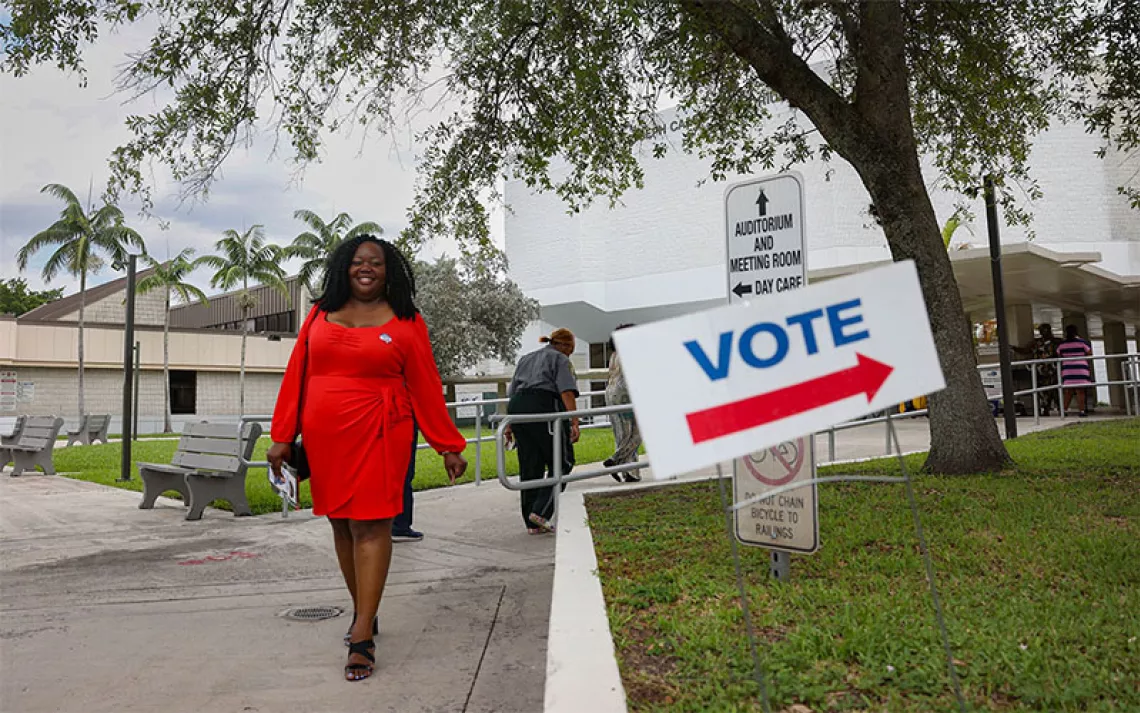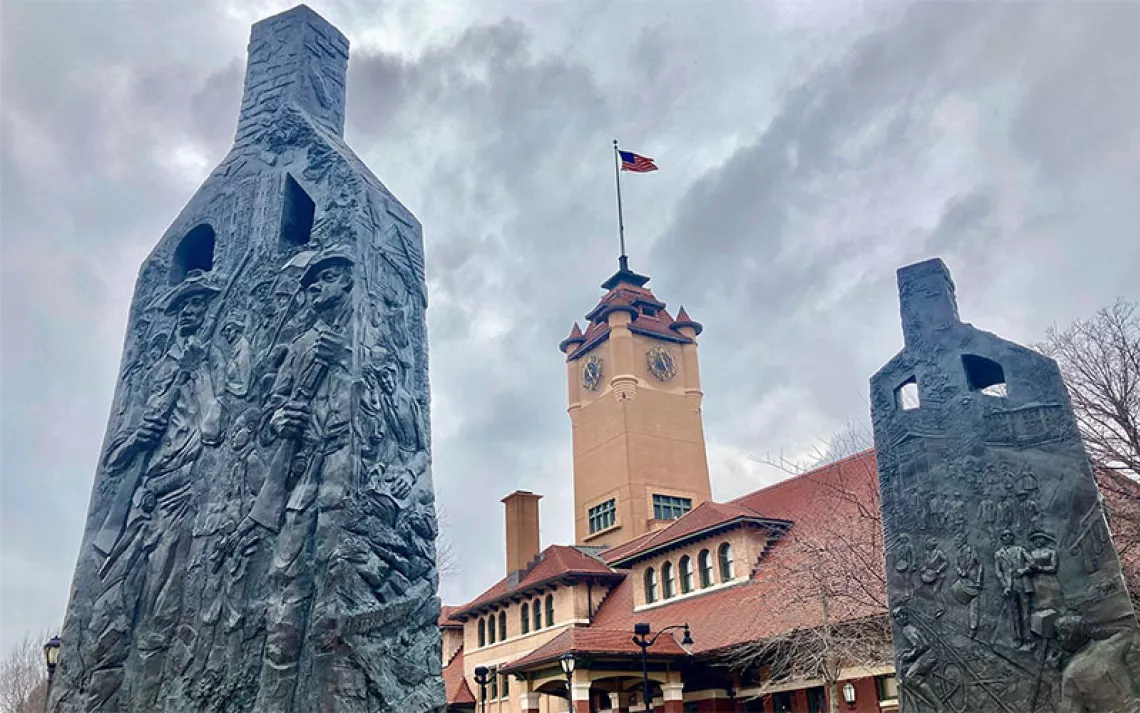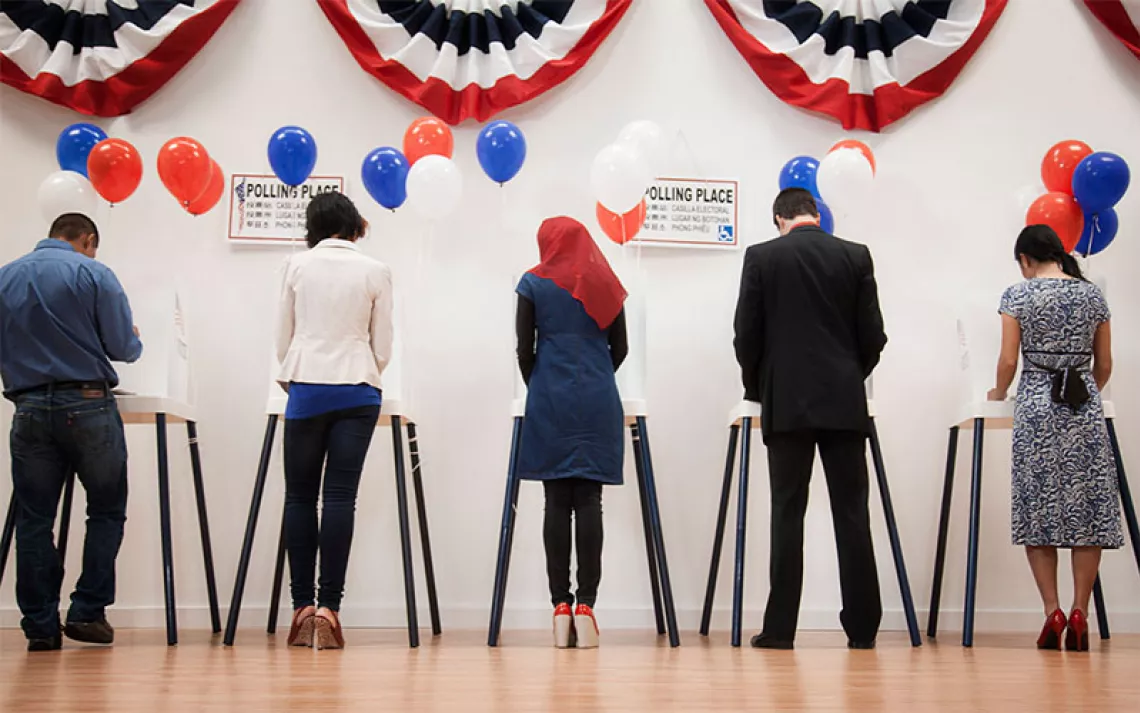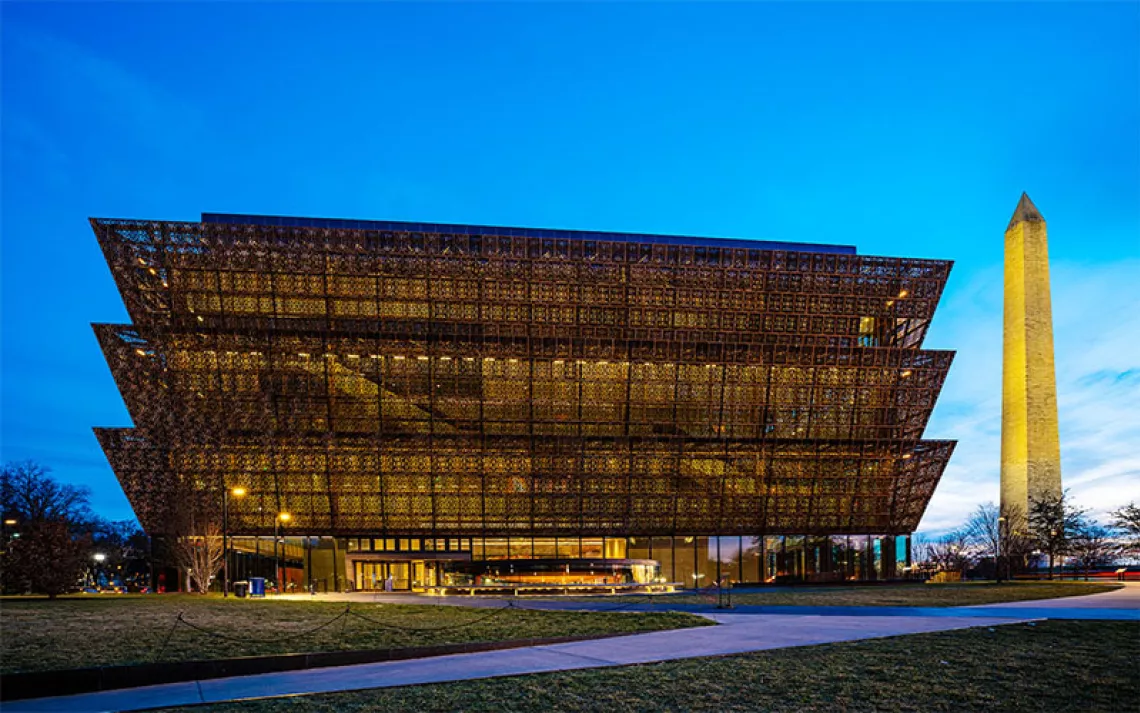The Climate Voters Are Coming
Arizona provides a glimpse of the climate action majority

Supporters of president-elect Joe Biden gather on Biscayne Boulevard, Miami, to celebrate in the moments after it was announced he had won the election. | Photo by Adam DelGiudice/SOPA Images/Sipa USA (Sipa via AP Images)
Things were red hot in Phoenix, Arizona, last Thursday. At the vote tabulation center of the Maricopa County Elections Department near downtown, a media circus unfolded as right-wing protesters, a couple of them armed, complained about a nonexistent vote-count suppression scandal called Sharpiegate (yes, this is a thing). By three in the afternoon, the temperature was a withering 99 degrees—the hottest November day in the Valley of the Sun since 1895. It was the punctuation to a week of heat that was, even by Arizona’s scorching standards, unseasonably uncomfortable. Election Day had a high temperature of 93—12 degrees above average—and in the final hours of ballot casting, the sunset had blazed against the Estrella Mountains on the west side of the desert metropolis.
There are a number of reasons why the former conservative stronghold of Arizona is turning blue this fall: The defection of some Republicans swayed by Cindy McCain’s Biden endorsement, an influx of people from California, a civically engaged and politically progressive Mexican American community, and an invigorated Indigenous voting bloc. Let’s add climate change, extreme weather, and worries about long-term sustainability to the list.
Last summer was brutal in Arizona. Phoenix experienced 144 consecutive days of high temperatures above 100. There were several strings of days above 110. The late-summer relief of the monsoon rains never materialized. As Election Day approached, climate advocates worked to ensure that citizens were ready to take their experience of extreme weather with them to the ballot box.
“People are thinking about it—independents are thinking about it, Republicans are thinking about it, Democrats are thinking about it,” Casey Clowes, a 28-year-old organizer with the Sunrise Movement’s hub in Tempe, Arizona, told Sierra as the votes were still being counted. “It doesn’t matter what party you are, you can feel the effects of extreme heat, so folks really are interested in that, regardless of party. And folks are really interested in water here. We get a lot or most of our water from canals that come from the Colorado River, and so I’ve had lots of conversations with voters about making sure we have enough water, making sure we’re using water sustainably.”
“We are at the center of experiencing the increasing temperatures and no rain,” Albert Celoza, a professor of political science at Phoenix College, said. “I think climate change has become a topic of discussion, all the time, within local government and politics.”
Joe Biden’s win in Arizona and the victory of Democrat Mark Kelly over Republican senator Martha McSally offer environmentalists a glimpse of that longed-for but elusive political species: the climate voter. That is, someone whose vote is largely influenced by, maybe even determined by, whether a candidate is a climate action champion. Get enough climate voters and the climate movement might even have a bloc—a group like gun voters or abortion voters or racial justice voters, who are so trained on a single issue that their intensity compels candidates up and down the ballot to address their concerns.
The 2020 elections marked a watershed for climate and the environment: For the first time in US politics, climate became a top-tier issue for voters and candidates. As recently as 2012, CNN journalist Candy Crowley dismissed citizens demanding a presidential debate question about climate change as “you climate change people.” This year couldn’t have been more different. The two presidential debates featured more than 20 minutes of candidate discussion about climate, and the topic also came up in the one vice presidential debate. During the last sprint to Election Day, Biden and Trump battled furiously (if shallowly) over the question of gas fracking. According to exit polling by Morning Consult (which obviously needs to be taken with a few million grains of salt given the state of polling), nearly three-quarters of Biden voters said that addressing climate change was “very important” to their vote. A fifth of Trump voters said the same.
During a post-election press conference last week, environmental leaders made the case that climate action is a winning political issue. “Make no mistake, this election is just the beginning,” Gina McCarthy, the head of the Natural Resources Defense Council and the former Obama administration EPA director said. “Climate change isn’t going away any time soon, and our fight to keep this a vital political issue isn’t going away either.”
“He [Biden] has made climate an essential element to his campaign, and so we expect that President Biden and Vice President Harris will have a decisive mandate to act with great strength and great clarity on climate change and protecting our air, and our water, and our communities when this administration takes office,” Michael Brune, the executive director of the Sierra Club said. “We’ll be able to replace someone who was a climate denier with someone who will rejoin [the] Paris [Agreement] and move our country to 100 percent clean energy.”
Yet while the Biden win is clearly a victory for environmentalists, voters also delivered mixed signals about their commitment to the kind of climate action needed to avert the worst-case global warming scenarios. As with so many elements of the 2020 election, the question of whether, how, and to what degree climate change may have influenced the outcome is … complicated.
“I’d love to be able to tell you there is a climate voter, but right now I am not feeling it,” RL Miller, the founder of Climate Hawks Political Action Committee and a Democratic Party activist who has long worked to elevate climate within the party, told Sierra last Thursday. “Believe me, I have been trying for years to build that bloc of climate voters. As of yesterday, I was prepared to say I have completed my life mission. But the Senate [outcome] has disheartened me.… I thought that Biden did a great job of running on climate. I really do. I am just not sure it’s resonating with enough voters to matter yet.”
If the Arizona experience tells one story, the results in Florida tell another. Just two days before the election, The New York Times released a poll (again, take it with a grain of salt) that showed that 57 percent of likely voters in Arizona and 54 percent of those in Florida were either “very worried” or “somewhat worried” about the impacts of global warming. Yet in Florida—a state that faces a threat to its very existence from rising sea levels—those concerns weren’t strong enough to tip the state for Biden. Evidently, voters’ tribal allegiance to Trump was greater than their worries about climate change.
“Climate clearly moves people. The question is, is there something that moves them more?” said Jamie Henn, a cofounder of 350.org who is now the director of Fossil Free Media. “There are plenty of things that influence people’s votes. I think this election showed that people really care deeply about climate change, and when it’s moved to the forefront, it helps move people toward the Democrats. And, at the same time, it is really hard to move the spotlight away from Trump. It’s complex.”
The outcomes of two South Florida congressional races illustrate that complexity. In Miami-Dade County, Republican Carlos Giménez defeated Democratic incumbent Debbie Mucarsel-Powell even as another Democrat, Representative Donna Shalala, lost her seat to Republican Maria Elvira Salazar. Both of those Republicans are, relatively speaking, advocates of climate action. As a local elected official, Giménez has sought to reduce greenhouse gas emissions, while Salazar campaigned on a pledge of “tackling climate change.” One takeaway: In South Florida, at least, one can support Trump and other Republicans while still being concerned about climate change.
“People can hold contradictions,” Henn said. “If 80 percent of people support a transition to clean energy, that means there are quite a few Republicans out there who want an energy transition and yet vote for the party of climate deniers.”
That may be the case in Florida, but the Southwest has a different political landscape—one that offers climate advocates hope that the new American majority of people of color and progressive whites will be anchored by climate voters.
In solidly blue Colorado, young voters concerned about climate change appear to have padded Biden’s margin of victory in the state, while also helping edge Democrat John Hickenlooper to a win over Republican incumbent Cory Gardner in the US Senate contest. The recent wildfires there—which are linked to warming temperatures and reduced precipitation—seem to have focused Colorado voters’ attention on climate. According to a poll commissioned by EDF Action, three-quarters of Colorado voters say that recent weather events such as wildfires have increased their concerns about the impacts of climate change.
In Arizona, the one-time home of conservative icons John McCain and Barry Goldwater, the seismic political transition is being driven, in part, by the votes of Latinos, Native Americans, and younger people—three constituencies that have especially high levels of concern about climate change.
“We know that Latinos, young people, and people of color care more about the environment and want to see more done,” said Laura Dent, executive director of Chispa, a project of the League of Conservation Voters that is focused on building Latino political power in the state. “We know they feel unrepresented in the political process, and that’s something we try to rectify with inclusive campaigns and conversations.”
During the past year, environmental groups poured millions of dollars into Arizona to get those constituencies to connect the dots between rising temperatures and the candidates’ positions on climate change. League of Conservation Voters, Chispa AZ, and affiliated entities spent a combined $9 million on community organizing, political ads, and other voter-engagement strategies on federal, state, and local races in Arizona. According to Pete Maysmith, the senior vice president of campaigns at the League of Conservation Voters Victory Fund, much of the expenditures in Arizona were focused on swing voters, “low-information voters,” and independents to get them to see “how bad Trump has been on climate, clean air, and clean water.”
Clowes, the Sunrise Movement organizer in Tempe, has evidence that the strategy worked. She spent the summer and early fall reaching out to students at Arizona State University and recent graduates, trying to engage them in conversations about climate change and the Green New Deal. She recalls one conversation with a twentysomething independent who didn’t know who was on the ballot besides Biden and Trump and who identified as undecided. “They really cared about the climate, and creating solutions to the climate crisis, and who is best prepared to address the climate crisis,” Clowes recalled. By the end of the conversation, the independent voter had committed to vote for Biden-Harris and Mark Kelly as the candidates “best ready to deal with this problem.”
Indigenous voters also played a major role in turning Arizona blue. According to an analysis by the Navajo Times, the Hopi and Navajo vote in the three counties that overlap with those tribal nations delivered nearly 74,000 votes to Biden, compared with just 2,100 for Trump. That’s a 97-to-3 split, and it may end up making the difference in a state where the vote differential between the two presidential candidates now stands at around 20,000. Climate and environmental concerns are a top issue among Native voters, according to Jade Begay, host of the podcast “Sko Vote Den” (the name is a play on Native American slang, “sko den” meaning “let’s go”).
“We’ve been seeing climate impacts on the Navajo Nation—and this goes for the entire Southwest—for a long time,” Begay said. “We’re experiencing droughts, and it’s a very harsh reality and it really impacts everyone’s livelihoods, especially if you are living on rural parts of the Navajo Nation and you depend so heavily on rainfall and the snowmelt coming in to water your crops and take care of your sheep.”
This immediacy of experience might explain the difference between voter behavior in Florida and voter behavior in the Southwest. Even though sunny-day flooding in South Florida is getting worse, sea level rise remains something of a distant, abstract threat. In contrast, this summer’s record-breaking heat in Arizona and the Colorado wildfires have been visceral and impossible to ignore.
The rise of the climate voter may depend on climate chaos becoming so personally terrifying that it comes to trump all other concerns. “I hate to say it, but I think that until more people have suffered climate harm and are willing to connect the dots, we won’t get there,” RL Miller said, noting that she nearly lost her home during the 2018 Woolsey Fire in California’s Ventura County. “Now, for me, this shit is personal.”
There’s little doubt that, eventually, a critical mass of climate-focused voters will emerge that will force the American political establishment—left, right, and center—into taking ambitious and sweeping action on climate change. The question left unanswered by the 2020 election is whether that will happen in time to avoid the worst—or whether those record-breaking November temperatures will keep climbing.
 The Magazine of The Sierra Club
The Magazine of The Sierra Club



